Want to learn how to jack up your truck safely and securely? Here is how professionals do it!
Have you upgraded from a regular car to a full-size truck recently? It’s a big step up (literally), but the main advantage is that it will allow you to go farther, higher, where smaller vehicles can’t even dream to go, and all while carrying a lot more gear. However, body-on-frame trucks are significantly heavier and built differently than regular unibody vehicles, so jacking up one isn’t as straightforward as jacking up a common Toyota Yaris, for instance.
Moreover, just buying a heavy-duty jack and calling it a day won’t cut it either here as there are several other factors to consider when lifting a truck or a bigger SUV. After all, when you have five to seven tons levitating above your head, there is no room for error (not that dropping a Yaris would be a better idea, but you get my point). Luckily, to help you jack up your truck safely no matter the type of jack you use or truck you drive, we’ve come up with a detailed step-by-step guide and made sure to add a couple of tricks of the trade and tips you can only learn after years in the field.
Put simply, no matter whether you need to install winter tires on your SUV in the comfort of your garage or fix a broken ball joint on your jacked Jeep Wrangler running 35s in the middle of a trail, we’ve got you covered!
Tools Required
Before we get into the how, let’s first look at some of the tools you’ll need to jack up your truck. Of course, we only mentioned a generalized list of tools, and the requirements can change based on specific situations.
1. A Jack
Duh.
Yeah, I know you know you’ll need a jack to jack up a truck lol. Still, there are several types of jacks available on the market these days, and not all of them are suitable to lift vehicles as heavy as a truck (and some that can are just a pain to use). So we thought we should first start by talking about the different jacks and a couple of pointers you should look for when buying one.
When lifting a truck, you can choose to go for either a floor jack or a bottle jack, and to be fair, both types work fine as long as you stay under the maximum weight limit.
Still, whenever possible, using a high-quality floor jack is usually the best course of action as they are more stable than bottle jacks and more than capable of lifting such high weights. Floor jacks with a dual-pump hydraulic system are especially favorable, thanks to their effortless lifting power combined with exceptional reliability.
Read more: 7 Best Floor Jacks For Lifted SUVs and Trucks
On the other hand, floor jacks are usually equipped with rather small metal casters and will consequently only work on flat ground. Of course, there is a couple of “off-road floor jacks” out there (take a look at the Pro Eagle Kratos 3), but they are kinda rare and somewhat expensive. Still, if you mostly work in a residential garage with a cement floor, a regular floor jack will do just fine.
Most floor jacks can lift your truck to approximately 25″, enough for a stock SUV or pickup truck. However, to jack lifted trucks, you will need a purpose-built floor jack or one equipped with dedicated high-lift extension attachments, depending on how high your truck is.
Meanwhile, bottle jacks are better for those who plan to use their trucks as intended — on an off-road trail. Floor jacks won’t roll on a muddy, rocky, and uneven trail, and can be challenging to position properly. Conversely, bottle jacks are much smaller yet equally powerful, making them easy to place under your truck. Besides, there is also a question of portability; most floor jacks are pretty large and heavy and will take up significant space in your truck (leaving it in your truck’s bed would be just as bad of an idea). On the flip side, bottle jacks are much more portable, thanks to the more compact design, and will easily fit under the front seats.
Also due to their vertical design, bottle jacks usually have a much higher weight capacity and will work wonders for box trucks, duallies, loaded cargo vans, and pretty much anything else, no matter how heavy it is (some bottle jacks can lift up to 30 tons so…)
As a general rule, use a floor jack when working in the garage or any smooth surface use a bottle jack for heavier trucks and emergencies. To carry out elaborate repairs on a trail, you can also keep two bottle jacks in your truck so you can lift a whole side at once, and in some cases, the entire thing off the ground.

2. Jack stands
Jack stands are essential to make sure you stay safe when working under your truck. They are usually made from industrial-grade steel and work using a locking pin mechanism to ensure your truck stays where you want it: up high.
Never get under your truck to perform repairs, especially not in a muddy trail, without using jack stands. Never.
Most jacks are hydraulic and a leak could send the truck slamming down on your body. Admittedly, this doesn’t happen often (I have never seen a leaking jack fall in 15 years), but to eliminate even the tiniest risk of injury to you or your loved ones, we recommend using jack stands at all times.
Read more: 9 Best Jack Stands for Cars, SUVs, and Trucks
The only exception to this rule would be if you are jacking up your truck to change a flat tire on the side of the road. Of course, if you don’t plan on leaning under there, the risk is significantly reduced. However, if you decide to take this route (or are forced to) be careful to keep your hands or any other body part clear of the truck’s tire.
I personally slide the removed tire under the truck as soon as I can. If the truck was to fall down, you might damage the wheel but at least, you’ll have about an extra 10-inch of leeway.
3. Wheel chocks
For those not in the know, wheel chocks are small wedge-shaped rubber pieces meant to prevent your truck from rolling on a sloping surface. You slide the chocks in front of and behind one or more wheels, and the specially formulated rubberized compound will grip onto the tarmac and keep your truck where it’s at.
There is no buying guide for wheel chocks, as you can’t really go wrong with any of them. Just make sure the chocks are proportionate in size to your truck’s wheel so that they can provide enough resistance, and you are good to go.
Yes, you can also slide a piece of 2X4 or a big rock under there but it’s not “recommended.”
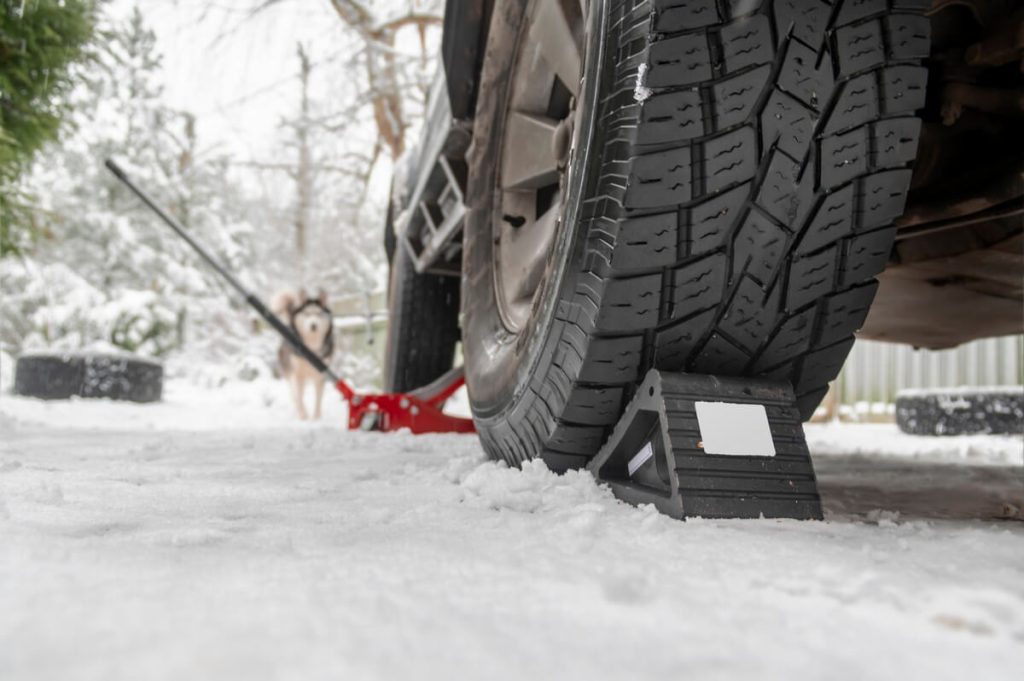
How to Jack Up a Truck Safely — Step-by-Step Guide
Now that you have all the tools you need to jack up your truck, we can finally go over the steps you need to follow. Of course, to stay as concise as possible, the step-by-step procedure below describes the process using a floor jack. If you intend on using a bottle jack, look out for a separate paragraph at the end of this article. Nonetheless, most of the process is quite similar with both types.
1. Find a suitable place to park your truck
The first rule of jacking is to find some level ground with plenty of working area. Your garage is the perfect place, but if you are on the road, any other solid and level ground will do just fine.
Of course, you aren’t expected to carry around a level everywhere you go, so here’s a simple trick to check for slight slopes putting you at risk. Stop your truck at the desired spot, put it in neutral and slowly take your foot off the brake pedal; if it starts rolling in any direction, find a more level location.
Moreover, if you need to stop on the side of a road with passing vehicles, make sure to park as far as possible from the road, especially if you need to remove a wheel on the left-hand side of your truck.
On the other hand, if you are in the middle of trail, far away in the woods, it’s very unlikely you’ll find solid ground anywhere close. In that case, I would suggest using a square piece of wood under your jack. The larger surface will make it a lot more stable and should prevent it from sinking in the mud. Just ensure to choose a piece of wood big enough to support the weight of your truck and you should be good to go.
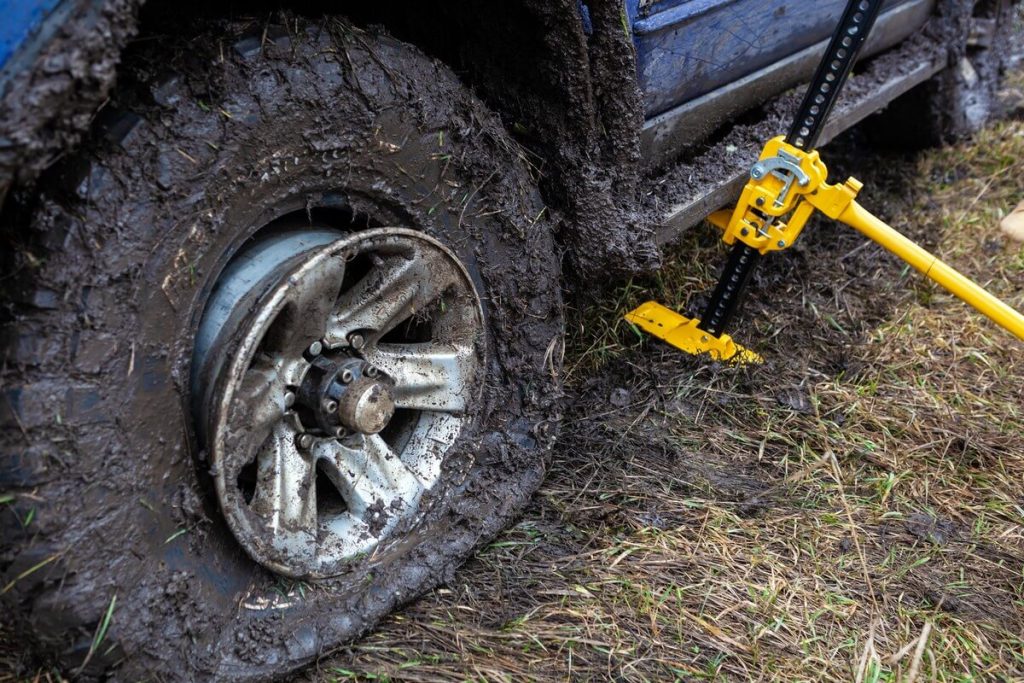
2. Engage wheel chocks
Once you’ve found a safe and level parking spot, it’s time to jack up your truck safely. First, put the truck in park and engage the emergency brake. Next, carefully place the wheel chocks around one or more wheels that will stay on the ground while your truck is jacked up. For example, if you place the jack near the front driver’s side wheel, place the wheel chocks around the rear passenger’s side wheel.
Of course, if you put the car in park and apply the handbrake, both front and rear wheels should be blocked fine, so why would you need wheel chocks? I have to admit that, when jacking cars and trucks in my shop, I rarely use wheel chocks myself. The ground is perfectly level and it’s very unlikely it would roll anywhere. However, when outside, you are never totally safe from a component failure (you never know when a parking brake cable might snap, for instance) and you are always better safe than sorry, especially in a trail.
And even if you were to find a fairly level area to park on, we still recommend using wheel chocks as an extra safety measure. If you don’t have any around, you can also use bricks or large pieces of wood — those work especially well on muddy terrain.
3. Picking the appropriate jacking point
Selecting an appropriate jacking point to place your floor jack’s saddle is crucial because one wrong decision and you could end up with permanent damage to the truck’s bodywork or expensive components. Luckily, no matter the make or model, all manufacturers will provide specific dedicated jacking points. if you are not sure where, you can always find this information in your truck’s owner manual. If the manual isn’t around, your best bet is to try and locate these points visually; they are usually marked with an arrow or a slight indentation under the rocker panel.
Since your truck is a body-on-frame vehicle and not a unibody model, you can also place your jack pretty much anywhere on the frame (watch out for rust, though) and under the control arms if your truck is equipped with an independent suspension. Moreover, if you want to lift an entire axle off the ground, you can also place your jack under the differentials.
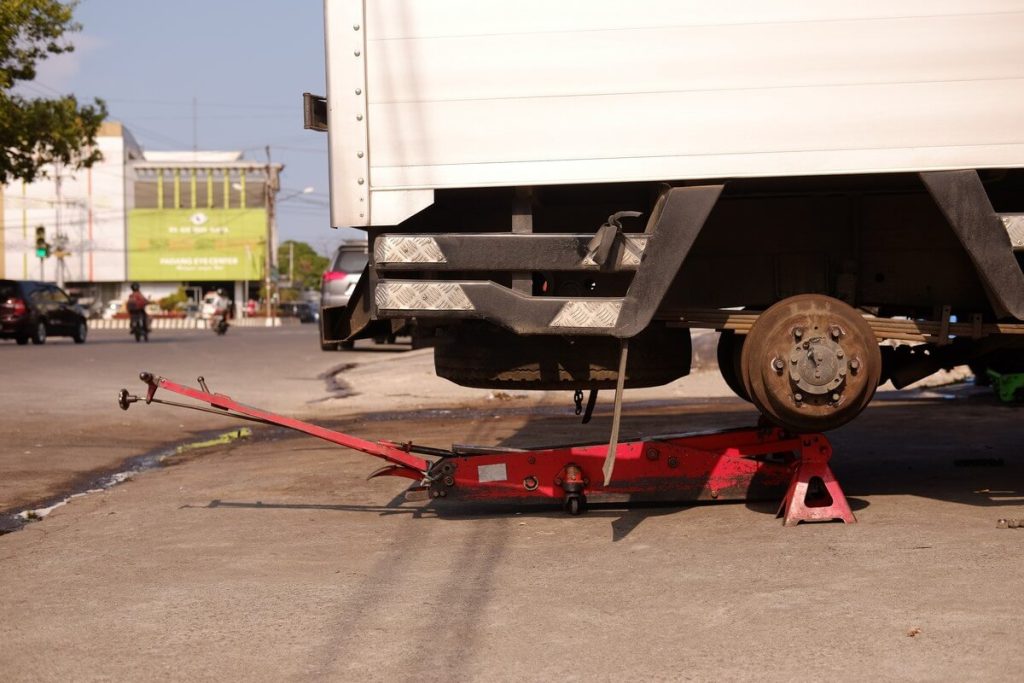
4. Jack it up
After selecting the right jacking point and placing the floor jack at the appropriate position, it’s time to start pumping. You will need anywhere between 12-15 pumps on average to get the truck sufficiently high to access the underbody. Once the truck is where you want it to be, carefully place a jack stand close to the saddle and twist the jack’s handle slowly until the hydraulic system releases enough pressure to set the truck on the stand. Be careful to jack up the truck slightly higher than the required final height, as you will lose a couple of inches while mounting it on the stands.
Before placing the jack stands, make sure to select the appropriate height and securely engage the locking pin. Once the truck sits on the jack stands, carefully slide the floor jack out and place it out of your way. You might want to give the truck a nice wiggle to ensure it is held securely before reaching under it — if it’s about to fall, it better fall while you are not under there.
5. Lowering the truck
Place the floor jack under the truck and start pumping. If you are lucky, certain floor jacks come with a fast-lift feature (usually a pedal), raising the saddle to its maximum height in 4-5 pumps. As the saddle gets closer to the lifting point, adjust the jack’s position to make sure it makes contact where you want it. Once you feel some resistance on the handle, put in a few extra pumps to clear the stand and remove it. Place the jack stand away before slowly lowering the truck back onto its wheels.
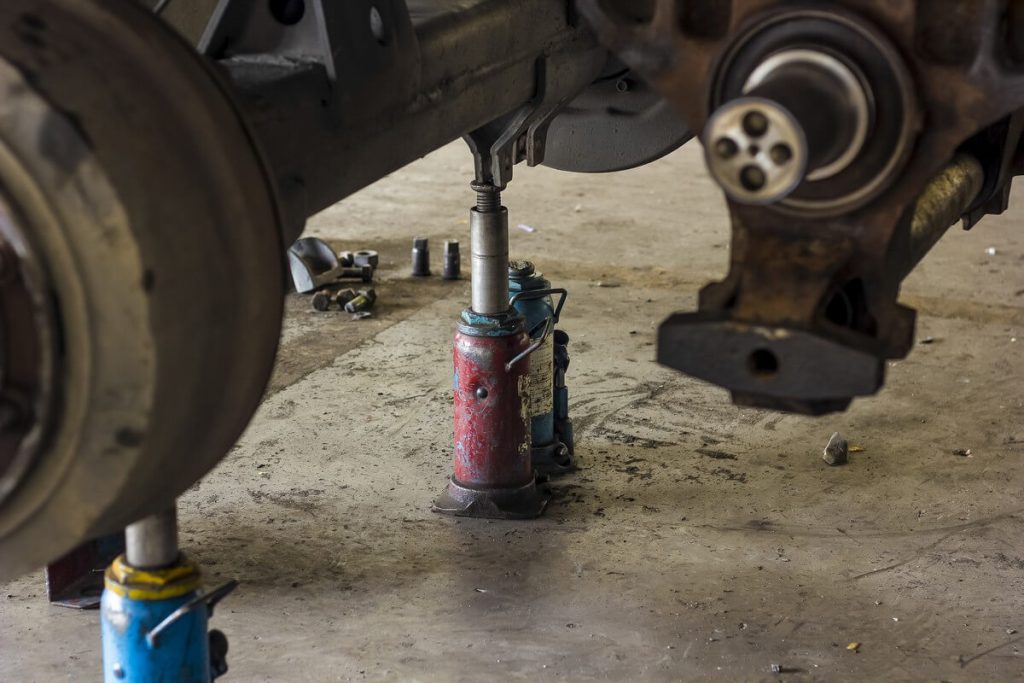
How to Jack Up a Truck with a Bottle Jack
Bottle jacks are designed differently but the procedure mentioned above remains pretty much unchanged. Just keep in mind that bottle jacks have a much smaller footprint, which can cause them to sink more easily in soft ground. They are also significantly easier to tip over — I would definitely not try to shake a truck sitting on bottle jack, but of course, that’s also why you should use proper jack stands.
The rest is pretty much the same: find a proper lifting point, slide the jack under there, lift the truck, place the stands, and that’s it!
Simple, right?
Last Words
Most people don’t realize the difference between jacking up a family hatchback and a 7,000 lbs. pick-up truck, until they have one. If this is your case, we hope this article will encourage you to perform some basic repairs or modifications on your own instead of spending a fortune on labor costs. After all, working on your beloved truck is the best way to spend your weekends, and that’s what we are all about here at GarageSpot.
However, keep in mind that lifting a truck is inherently riskier than lifting just any other car, and as such, we encourage you to take as many precautions as possible and always be attentive while working under there.
Play safe, y’all!






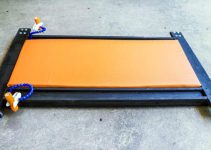

Great post! I found the step-by-step instructions really helpful, especially the tips on choosing the right jack. Safety is so important when working under a truck. Thanks for sharing your expertise!
Thanks for the kind words mate!
Glad to you liked it! 💪